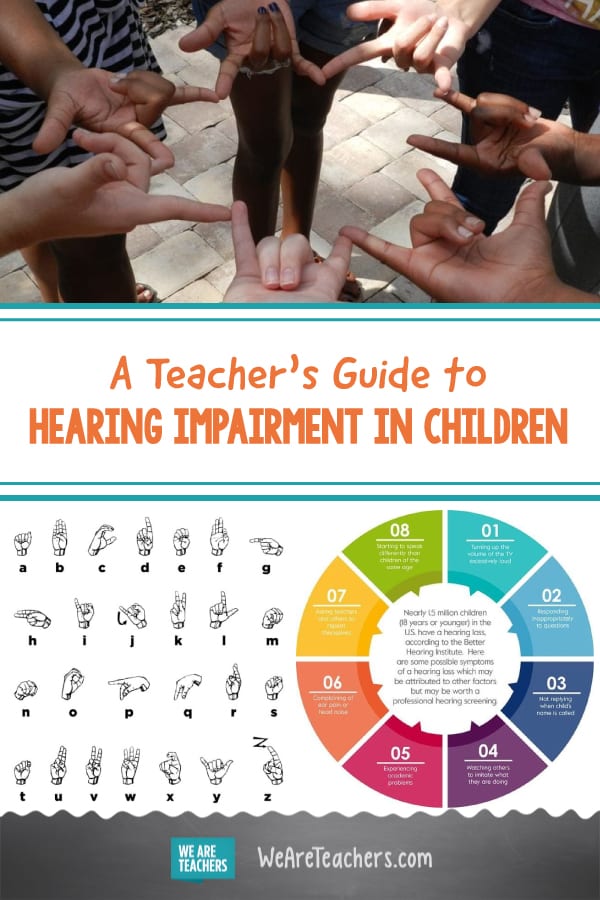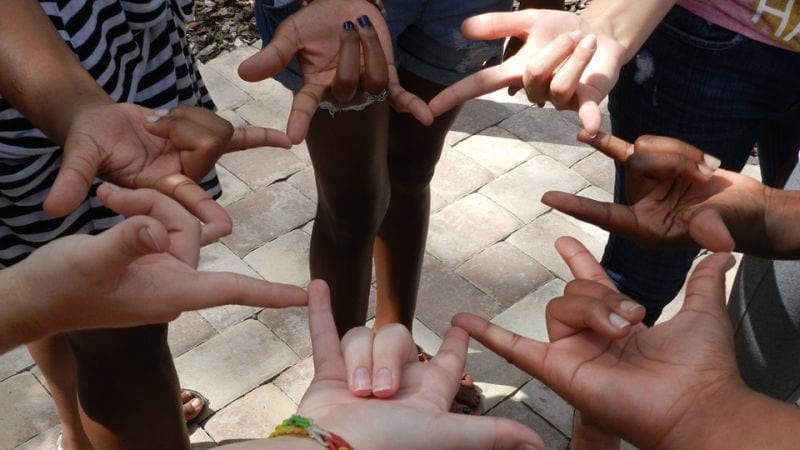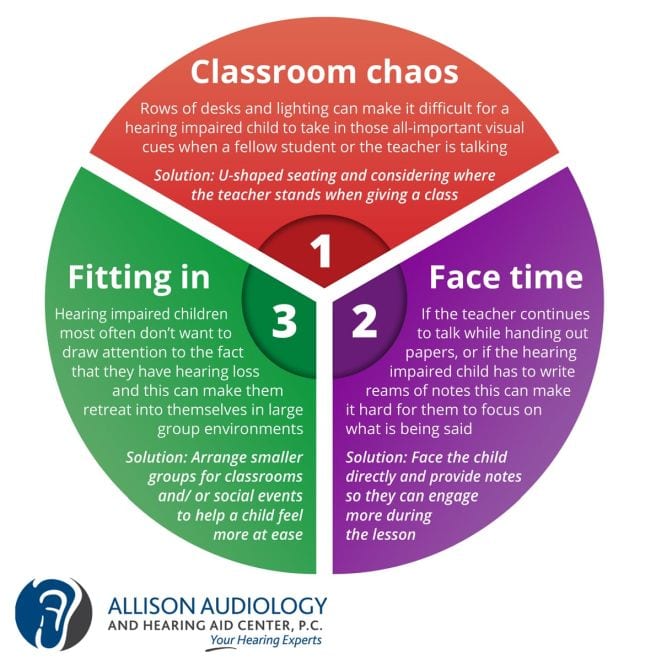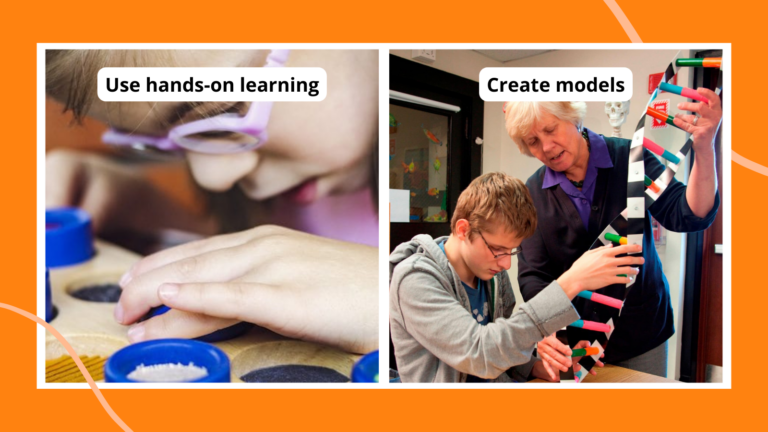Here’s a statistic that might surprise you: according to the CDC, as many as 15% of school age children have significant hearing loss in at least one ear. Hearing loss in children can vary from mild, where a child might have difficulty hearing over background noise, to severe, rendering a child completely deaf. Students who are deaf/hard of hearing (DHH) face special challenges in the classroom, but given the right accommodations, they can succeed academically. Here’s what teachers need to know.
Know the signs of potential hearing loss in kids.
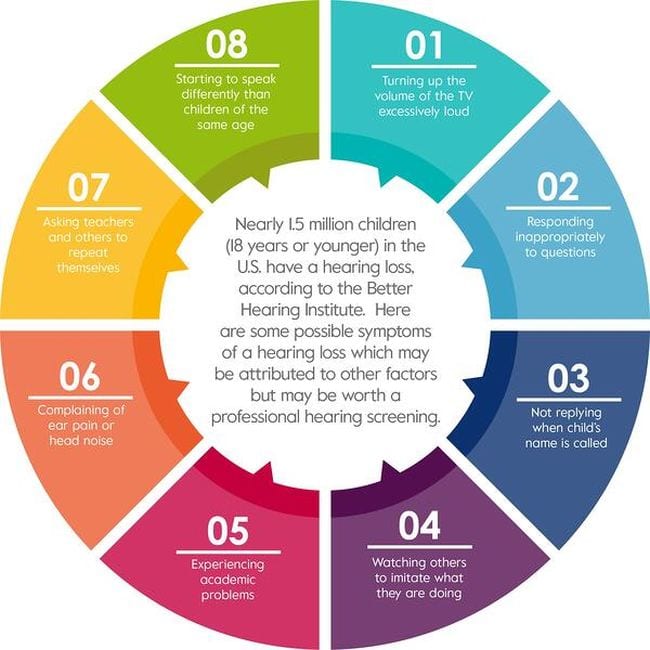
via Amplifon
Severe hearing loss is usually identified before a child enters school. However, mild to moderate hearing loss may not be recognized until a child is older. Hearing loss due to injury, illness, or disease can begin later in life too. Teachers should know what signs of hearing loss to look for in their classroom and recommend a hearing screening as needed.
Kids are often reluctant to speak up when they can’t hear well, so watch for patterns of behavior including the signs shown above. If a student regularly asks you to repeat instructions, misunderstands questions, or doesn’t hear when you call their name, check in privately to ask if they’re having trouble hearing. Even if they say they’re not, continue to watch for signs and don’t hesitate to talk with their parents.
[contextly_auto_sidebar]
Recognize the challenges children who are deaf/hard of hearing face in the classroom.
Most teachers no longer use a traditional teaching style, facing the class while they lecture from the front. This is terrific for accommodating a variety of learning styles, but makes life in the classroom much harder for children who are deaf/hard of hearing, as they often cannot see the teacher’s lips or hear them well when they move around the classroom. Here are some other ways hearing loss causes challenges in school.
- Background Noise. For kids with mild to moderate hearing loss, background noise can be their biggest enemy. Since many classrooms are now a hum of busy activity all day long, it’s much more likely these kids will miss or have difficulty hearing instructions or feedback.
- Acoustics. When a teacher stays in one place, children who are deaf/hard of hearing can be placed close to them. But they still may not hear other students across the room, or pinpoint where a sound is coming from.
- Back-lighting. For students who lip-read or work with a sign language interpreter, sitting facing a window or other strong light source makes it hard or impossible to see what’s being said.
- Note-taking. Taking notes while a teacher talks is a nearly futile task for children who are deaf/hard of hearing.
- Difficulty Collaborating. Group work is common and helpful in most classrooms. But students who are deaf/hard of hearing find this difficult, as they often can’t understand others. If they aren’t comfortable asking for help, they’re likely to be left out.
- Social Concerns. Those same problems apply to social situations like lunch or recess. Kids with hearing loss can become isolated and have difficulty making friends.
Find more information about challenges facing students who are deaf/hard of hearing here.
Adjust your classroom and teaching style to help lip readers.
Children with any level of hearing loss may use lip-reading to get by. But lip-reading is not only a difficult skill to acquire; it also relies heavily on guesswork. In fact, it’s estimated that only about 30-60% of words are seen clearly by lip readers. For the rest, it’s like putting together a puzzle without having all the pieces. But teachers can make it easier for lip readers in the classroom.
Make eye contact, speak clearly and normally, but don’t shout.
Always be sure you have the lip readers’ attention. Ask if it’s okay to touch their arm if you need them to look at you. Form your words clearly, and if you’re a fast talker, make an effort to slow down just a bit. (All your students will benefit from this.) Talk in a normal tone of voice; shouting can actually distort your mouth.
Arrange seats in a horseshoe or circle.
Lip readers should be able to see all the faces in the classroom during discussions. When possible, a circle or horseshoe is ideal. If not possible, place them close to the front of the room in a seat of their choice, and always repeat any questions or comments from students they may not be able to see.
Reduce back-lighting concerns.
When a teacher or other students are lit from behind, their faces are much harder to see. Close curtains and use overhead lights to ensure everyone is equally well-lit during class.
Give hearing-impaired students a moment to identify who is speaking.
During discussions, new speakers should allow a moment for those who are deaf/hard of hearing to turn their way before talking. Avoid talking over one another so they can focus on one person at a time.
Learn to work with a sign language interpreter.
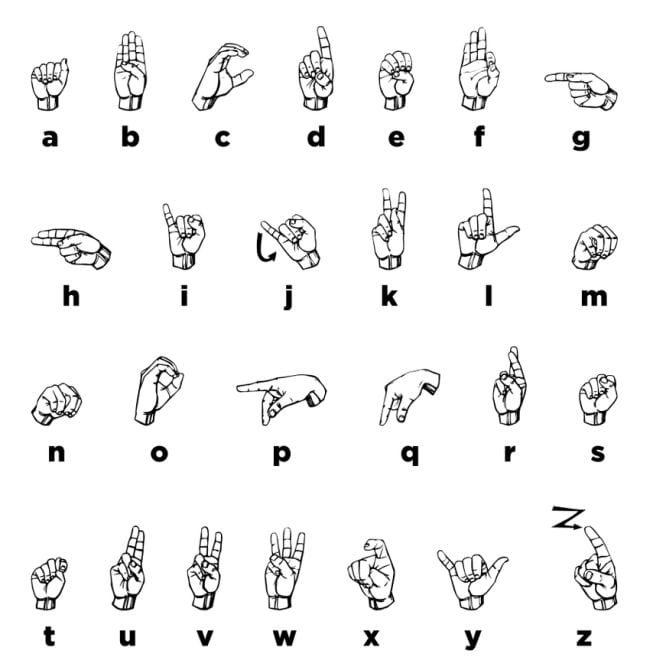
The American Fingerspelling Alphabet
One way to accommodate kids who are deaf/hard of hearing is the use of a sign language interpreter during class. These interpreters are skilled experts who can make things better for both teacher and student, but you’ll need to work closely with them to get the most benefit.
Seat the student close to and facing both the teacher and the interpreter.
Make sure the student can see both of you, and that you’re both properly lit. (See concerns about back-lighting above.)
Speak clearly and use specifics.
Sign language interpreters can keep pace with most speakers, but they’ll appreciate it if you talk clearly and at a regular pace. Make sure to use specifics when giving directions (for instance, say “put your name in the top left corner” instead of “put your name here”.)
Provide vocabulary lists in advance when possible.
In classes like science, kids are always learning new vocabulary words. Sign language interpreters might have to learn them too, if the subject isn’t one that’s familiar to them. Provide them a list in advance of words relevant to the current topic, so they can see if corresponding signs exist and teach them to their student. When signs don’t exist, interpreters will need to use fingerspelling, and they may need assistance with more complicated terms and subject jargon.
Talk directly to the student during class, not the interpreter.
Always interact directly with the student when asking or responding to questions or comments. You don’t need to acknowledge the interpreter each time they speak for the student. Let them do their job while you do yours.
Make additional accommodations for children who are deaf/hard of hearing.
Along with lip-reading and interpreters, students may use technology like hearing aids, assistive listening devices, and captioning or transcription. With or without this technology, teachers can also make a variety of accommodations to help these students learn. In many cases, an IEP will detail the adaptations needed.
Face students when speaking, and be sure you have their attention.
This is a good tip for all teachers, in every class. Make eye contact with students so you know you have their attention. Avoid giving instructions while passing out papers or moving around the room. Speak clearly and at a normal speed. For students who are deaf/hard of hearing, ask how they’d like you to get their attention before speaking.
Provide study guides and pre-written notes.
Taking notes while listening to a lecture isn’t an ideal way to learn for kids who are deaf/hard of hearing, even if they lip read or have an interpreter. Providing a general outline or pre-written notes, preferably in advance, is better. This allows them to pay attention and interact in class.
Allow time for students to review slides or handouts before speaking.
Slideshows are a great way to help all students follow along in a lecture. When you flip to a new slide, allow a minute for everyone to read what’s there before talking. Students who are deaf/hard of hearing can’t read a whiteboard at the same time they’re trying to lip-read or look at their interpreter. The same goes for handouts or other visual aids.
Check frequently for understanding and questions.
Students who are deaf/hard of hearing might be unwilling to interrupt when they don’t understand. Give them more opportunities by pausing more frequently to check for understanding (something else your whole class can benefit from). Additionally, make it very clear when you’re about to change topics and move on to something else, and allow some time for final notes or processing.
Use technology to help you out.
We live in a brave new world! Take advantage of speech-to-text technology. Use detailed slideshows and chat/messaging programs. Show streaming movies with closed captioning turned on. Always be on the lookout for new ways technology can improve learning.
Teach other students to communicate with those who are deaf/hard of hearing.
One of the major drawbacks for children who are deaf/hard of hearing is that they can suffer socially. Open up a better, brighter world for them by encouraging your other students to learn how to best interact with them. Teach your class basics signs and fingerspelling. Help them learn the best ways to talk to a lip-reader. Seek out playground games that don’t involve hearing. Pair a kid who is deaf/hard of hearing with a friendly buddy classmate who can assist them as needed. Plan field trips that all your students can enjoy. Above all, don’t let a student who is deaf/hard of hearing feel isolated and avoid singling them out whenever you can. They really just want to be “normal” kids, so help them feel that way when you’re able.
Resources
Books:
- How Deaf Children Learn: What Parents and Teachers Need to Know (Marschark/Hauser 2011)
- The Gallaudet Children’s Dictionary of American Sign Language
Online:
- Tips for Teaching Students Who are Deaf or Hard of Hearing, University of Maryland
- Appropriate School Facilities for Students With Speech-Language-Hearing Disorders, ASHA
How do you help students who are deaf/hard of hearing succeed? Come share on the WeAreTeachers HELPLINE Facebook page.
Vision loss can also cause students to suffer academically. Learn the 9 signs that could mean your student has a vision problem here.
